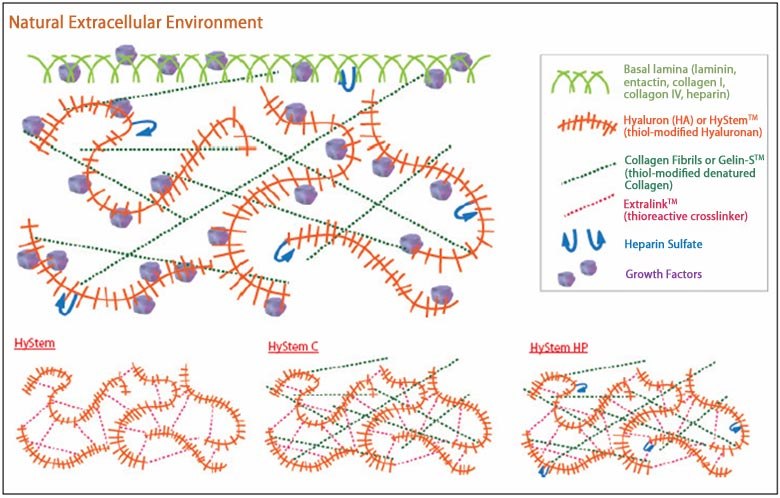HyStem™ Hyaluronic Acid Based Hydrogels for 3D Cell Culture Applications
Introduction
HyStem™ is a semi-synthetic 3D hydrogel platform that allows cell growth in a 3D environment. Their main component is one of the major constituents of the extracellular matrix (ECM), hyaluronic acid (HA). HA is the simplest glycosaminoglycan (a negatively charged, linear, non-sulfated polysaccharide) that provides compression strength, lubrication, and hydration within the ECM1. It also regulates cell adhesion and motility2,3 and mediates cell proliferation and differentiation4, making it not only a structural component of tissues but also an active signaling molecule. Hystem™ hydrogels have been extensively published for numerous applications including stem cell, cancer and neuroscience research.
Three different HyStem™ platform options are available:
- HyStem™ (GS311F) is composed of thiol modified HA (Glycosil®) and thiol reactive crosslinker (Extralink®); the crosslinker allows for the gelification process (without it, HA solution will stay liquid)
- HyStem™ C (GS313F) includes Glycosil® and Extralink® but also thiol modified denatured collagen fibris called
Gelin-S® to accommodate some cell attachment needs (e.g. Stem cells) - HyStem™ HP (GS315F) includes all of HyStem™ C plus heparin sulfate to ensure growth factor release at the immediate proximity of cells

Figure 1. Biochemical structure of Hystem™ hyaluronic acid based 3D hydrogels.HyStem™ HA hydrogels closely mimic the native extracellular matrix protein environment giving customers options of HA, HA+ collagen or HA+ collagen+ heparin sulfate linked hydrogels for 3D cell culture support and growth. The hydrogels are customizable and allow attachment of other growth factors and ECM proteins.
HyStem™ Features and Benefits
- Biologically accurate: HyStem™ kits are optimal for culturing stem cells whose natural environments are rich in hyaluronic acid. The HyStem™ hydrogel scaffold closely mimics the rich, natural extracellular matrix environment with hyaluronic acid and collagen fibrils.
- Customizable: The HyStem™ platform allows growth factor incorporation, attachment factor incorporation and ECM protein incorporation so you can modify the rigidity of the hydrogel, and do cell encapsulation vs. top plating.
- Semi-synthetic: Because the HyStem™ platform is a synthesized matrix and not a biological extract, the composition of their cells’ environment is more closely controlled. HyStem™ components include chemically synthesized HyStem™ (thiolated hyaluronic acid) and Extralink® (thiol-reactive crosslinker).
Publications using HyStem™ with Applications
A hyaluronan hydrogel scaffold-based xeno-free culture system for ex vivo expansion of human corneal epithelial stem cells. Chen D, Qu Y, Hua X, Zhang L, Liu Z, Pflugfelder S C and Li DQ. Eye (Lond). 2017 Jun;31(6):962-971. Demonstrates that HyStem™ C can successfully support the ex vivo cultivation of human corneal epithelial stem cells (CESCs). It has been shown several times that HyStem™ C is a very suitable carrier for ex vivo experimentation with numerous types of stem cells.
Mesenchymal stem cells support growth and organization of host-liver colorectal-tumor organoids and possibly resistance to chemotherapy. Devarasetty M, Wang E, Soker S, Skardal A. Biofabrication. 2017 Jun 7;9(2):021002. This paper used HyStem™ HP in a study of host-liver colorectal-tumor spheroids composed of primary human hepatocytes, mesenchymal stem cells (MSC) and colon carcinoma HCT116 cells were created in simulated microgravity rotating wall vessel (RWV) bioreactors. The cells were seeded on HyStem™ microcarriers, loaded with liver-specific growth factors and ECM components.
3D microvascular model recapitulates the diffuse large B-cell lymphoma tumor microenvironment in vitro. Mannino RG, Santiago-Miranda AN, Pradhan P, Qiu Y, Mejias JC, Neelapu SS, Roy K, Lam WA. Lab Chip. 2017 Jan 31;17(3):407-414. UsedHyStem™ C to develop a lymphoma-on-chip model consisting of a hydrogel based tumor model traversed by a vascularized, perfusable, round microchannel that successfully recapitulates key complexities and interactions of the in vivo tumor microenvironment in vitro.
Cell-cell interaction between vocal fold fibroblasts and bone marrow mesenchymal stromal cells in three-dimensional hyaluronan hydrogel. Chen X, Thibeault SL. J Tissue Eng Regen Med. 2016 May;10(5):437-46. This paper used HyStem™ C for coculture of vocal fold fibroblasts (VVF) and bone-marrow deriver mesenchymal stromal cells (BM-MSCs).
Multilayered Hyaluronic Acid-Based Hydrogel Formulations Suitable for Automated 3D High Throughput Drug Screening of Cancer-Stromal Cell Cocultures. Engel BJ, Constantinou PE, Sablatura LK, Doty NJ, Carson DD, Farach-Carson MC, Harrington DA, Zarembinski TI. Adv Healthc Mater. 2015 Aug 5;4(11):1664-74. This paper used HyStem™ C to develop HTS suitable for 3D co-culture systems, mixing cancer and stromal cells.
Related Products
References
To continue reading please sign in or create an account.
Don't Have An Account?